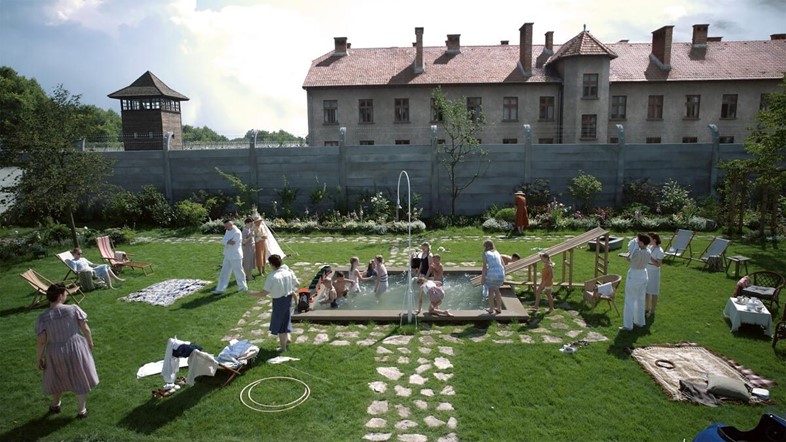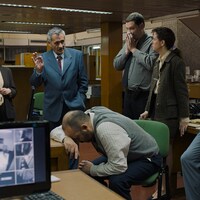Jonathan Glazer’s Oscar-nominated movie never takes us behind the walls of Auschwitz – and this is what makes it so effective
Jonathan Glazer’s Holocaust drama The Zone of Interest is not like the Holocaust stories we have grown used to. The film, loosely based on Martin Amis’ 2014 novel of the same name, follows Nazi commandant Rudolf Höss and his wife Hedwig as they live out their dream family life in an idyllic house next to Auschwitz. Höss takes their children out to swim and fish, while Hedwig tends to their beautiful and expansive garden, immune to the horrors taking place just over the looming walls of the concentration camp.
The film is a serious contender in the Oscars race, but is unlike many other depictions of the Holocaust that have shared its acclaim. The majority tend to follow the victims, either from within concentration camps or as they attempt to evade capture (like The Pianist), or they focus on the actions of those attempting to thwart the Nazi regime (like Schindler’s List). Films which focus on the Nazi perpetrators have historically been met with mixed criticism, such as the Oscar-winning The Reader, which was criticised for Holocaust revisionism and making Kate Winslet’s concentration camp guard Hanna Smitz an object for audience sympathy. Similarly, Taika Waititi’s Jojo Rabbit also faced criticism for its inclusion of a sympathetic Nazi character in Sam Rockwell’s Captain Klenzendorf. And we do not speak of The Boy in the Striped Pyjamas, condemned by the Auschwitz Memorial Museum themselves.
The Zone of Interest also stands in stark comparison to the swathes of Holocaust literature we have seen published recently. Titles such as Heather Morris’ The Tattooist of Auschwitz, Mario Escobar’s Auschwitz Lullaby, and Jeremy Dronfield’s The Boy Who Followed His Father into Auschwitz all fall under the umbrella of ‘Holocaust kitsch’ or ‘Holokitsch’ – stories which claim to bring these ‘untold stories’ to life and give dignity to victims, but instead trade in sentimentality and voyeurism. Polish academic and writer Sylwia Chutnik has termed this genre of writing ‘Holo-polo’, combining the words ‘Holocaust’ and ‘polo’ from the term ‘disco-polo’, a popular Polish music style that combines dance music with simple, often raunchy or romantic lyrics. These books might feature different characters and literary styles, but there is one main similarity: “cheap sentimental tones and emotions”, according to Chutnik.
Glazer’s film resists these familiar narratives, the “easy reading packaged in barbed wire” that Chutnik condemns. The film is always teetering on the edge of showing us something truly horrific, of showing exactly what is happening behind the walls of Auschwitz, but never does. It is enough that the characters know and that they approve, gleefully doling out confiscated clothes from the prisoners and hearing pitches for the latest in crematoria technology. That they revel in their position is the horror.
Knowledge of what is going on in the camp comes to us through the film’s chilling soundscape. It’s an ambient soundtrack of daily life punctured by gunshots, screams, the barking of dogs, trains, and the roar of the crematoria. The ability of the Höss family to ignore or tune out these sounds as they garden and play speaks to their cold-blooded approval of the genocide. In one particularly disturbing scene Höss and his son horseback ride through meadows while prisoners are made to march through neighbouring fields. The son calls attention to a sound, we presume he is referring to the people suffering only metres away, but he is in fact referring to a heron he somehow hears beyond the torment of the prisoners – something impossible to hear for the audience.
Glazer uses fixed cameras for many of the shots, particularly those inside the Höss house, which often ensure camp watchtowers or plumes of smoke are visible through windows as the characters get dressed or do chores. Richard Brody, reviewing the film for The New Yorker said that Glazer “shrinks from portraying the horrors of the real-life Höss’s character” and that he doesn’t allow “room for the victims” who are “given neither any voice nor any point of view”. But we have to ask ourselves why we have such a craving for those tales from inside the camps. At what stage does ‘giving victims a voice’ turn into exploitation?
Current trends in popular culture show that we have an insatiable appetite for trauma. Parul Seghal raises the question: “in a world infatuated with victimhood, has trauma emerged as a passport to status?” It seems that exploring the trauma of the Holocaust has been the passport to status for many of the novels in the Holo-polo or Holokitsch genre. Would they not have just been deemed sensational and sentimental historical fiction without the Holocaust legitimating their status as ‘important’ stories? Are they just commodifying the victims they claim to give voice to?

Glazer doesn’t shrink from the horrors at all. Yes, the film is bloodless, receiving a tame 12A rating, but all that means is that the gory details are absent. The horror of the genocide still remains strikingly present throughout. We all know exactly what went on behind the walls of Auschwitz. To show it again and again on screen starts to feel exploitative – how many times do we need to watch the simulated brutalisation of a people before we are satisfied we have paid our respects? Is it not a damning indictment of our own priorities that we need something to tug on our heartstrings to get us to pay attention to genocide?
The Zone of Interest forgets sympathy and forces us into a different emotion. By giving us only the day-to-day lives of the Höss family, the annoyances of running a home, your spouse moving away and putting work before family, we are forced into a kind of mundane complicity with what is going on just beyond the wall. You feel complicit because you cannot escape from watching the family; you must watch the callous and uncaring Nazis and sit by while people scream. Rather than letting the viewer rest in the familiar and comfortable feeling of sympathy, Glazer’s film hopes to shock us out of being bystanders to genocide – to confront the potential of our own complicity – by forcing us into the role ourselves.




